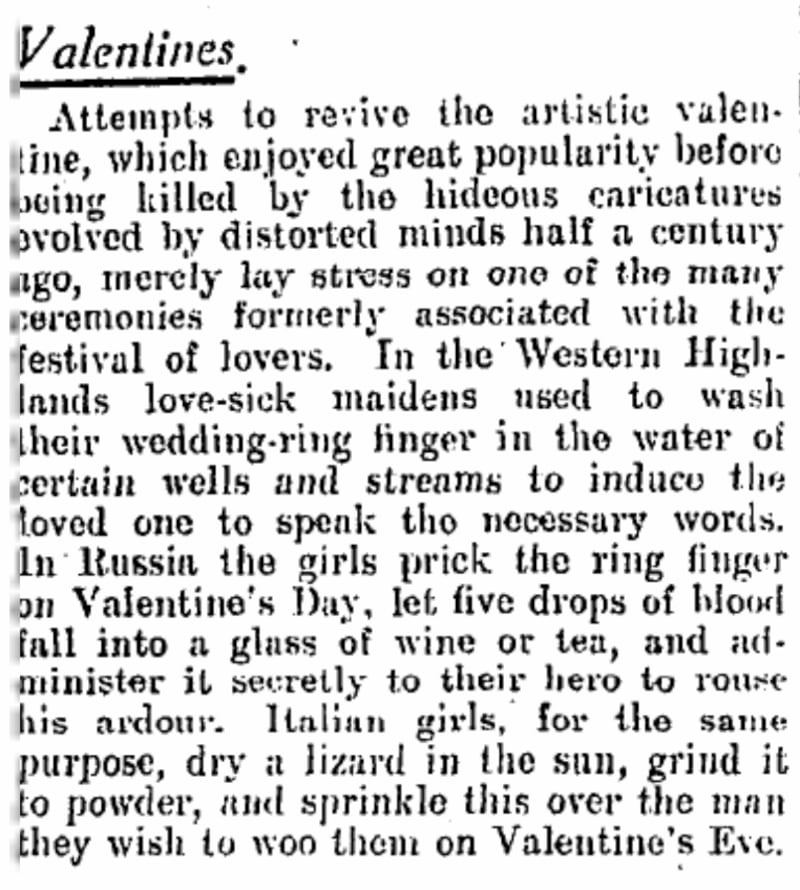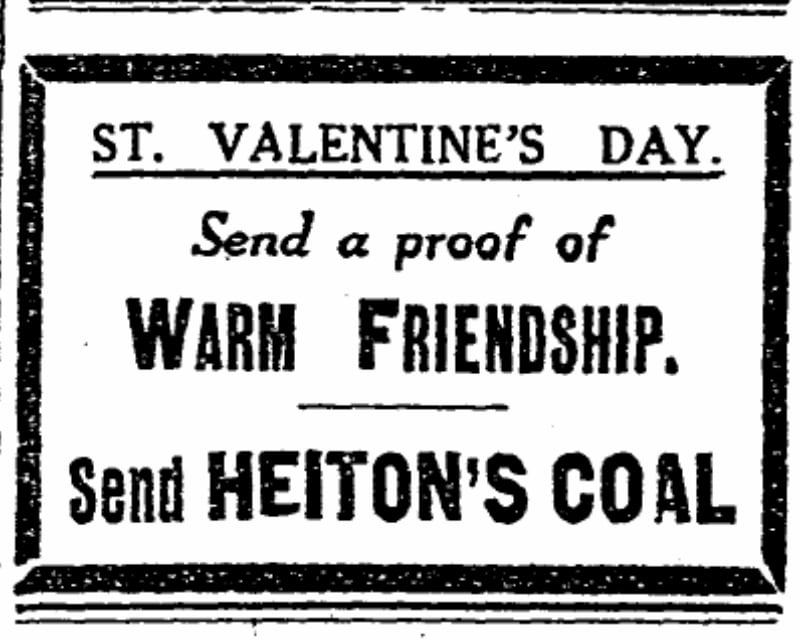Valentine's Day is often dismissed as a victim of contemporary commercialism, a "Hallmark holiday" usurped by modern capitalism. But rest assured, since the birth of newspaper advertising, it was ever thus. The Irish Times ad pages over the decades demonstrate rampant Valentine's consumerism going back to the 1860s, so today's rush-bought petrol station flowers are simply following a grand tradition.
On February 9th, 1869, J Wiseheart – how’s that for nominative determinism? – of Suffolk Street in Dublin advertised their Valentine’s Day wares: “For the last forty years the most extensive importer and manufacturer of Valentines, perfumed sachets, fancy envelopes in Ireland, takes leaves to solicit an early inspection of his superior new stock. An endless variety of juvenile subjects.”
Another Wiseheart was on O’Connell Street, then Sackville Street, as advertised in the newspaper in 1870, “VALENTINES: The most recherché and elegant assortment of the above, which for taste, style, and elegance cannot be surpassed by any other house in this trade, is now on view at Bernard Wiseheart’s.”
Fancy stationers
Valentine's Day business was booming at this time. "With the returns of St. Valentine's Day," a report in the Latest News section of the paper read on February 12th 1874, "the fancy stationers of Dublin are giving ample evidence of preparation to meet the demands certain to be made upon them. With the leading firms the displays are enormous, and all tastes and means can be satisfied at rates varying from a penny to more than five guineas." A long list of establishments selling Valentines followed.
In the lead up to Valentine’s Day in 1875, Lawrences at Great Bazaar, 5 and 7 Upper Sackville Street, was also advertising. “Useful and elegant. Souvenirs of every description, fitted up superbly in satin. Perfumed sachets comprising new moonstone brooches, eardrops, pendants and scarf pins, garnet and gilt jewellery, fans, smelling bottles, vinaigrettes, bouquet holders, mirrors and innumerable other articles.”

That year, Walter Sexton a jeweller on Grafton Street was also upping the Valentine game, “the prettiest valentine is one of the posey, or love rings,” their advertisement ran, “these rings are a revival of the ancient posey or motto ring. Each ring having engraved upon its beautiful inscription, suitable for the present occasion after the custom of the olden time. A list of these rings, containing over 50 different mottoes sent free by post. Manufactured only in 18 carat gold.”
Posey rings gained popularity between the 1400s and 1600s, primarily in England and France. The name doesn’t come from the flower, but poésie, as in the French word for poetry.
By 1883, Lawrences was increasing its variety of Valentines, “Ivory and porcelain valentines, hand-painted designs, and names, words, or mottoes will be written on them in a few minutes without extra change.”
Traditional Valentine activities
At the end of the 1920s, traditional Valentine activities were being remembered in An Irishman's Diary, on February 14th, 1929. "Attempts to revive the artistic valentine, which enjoyed great popularity before being killed by the hideous caricatures evolved by distorted minds half a century ago, merely lay stress on one of the many ceremonies formerly associated with the festival of lovers.
“In the Western Highlands love-sick maidens used to wash their wedding-ring finger in the water of certain wells and streams to induce the loved one to speak the necessary words.
“In Russia the girls prick the ring finger on Valentine’s Day, let five drops of blood fall into a glass of wine or tea, and administer it secretly to their hero to rouse his ardour.”
How does that sound instead of today’s traditional overpriced restaurant set menu?

“Italian girls, for the same purpose, dry a lizard in the sun, grind it to powder, and sprinkle this over the man they wish to woo them on Valentine’s Eve.”
Beyond advertising gifts and cards, advertising on Valentine’s Day took a turn in the 1930s in the newspaper, “St. Valentine’s Day. Send a proof of warm friendship,” an ad on Valentine’s Day, 1931 read, “Send Heiton’s Coal.”
Well, better than nothing, I suppose.
This 2019 article was edited on February 13th 2022
















